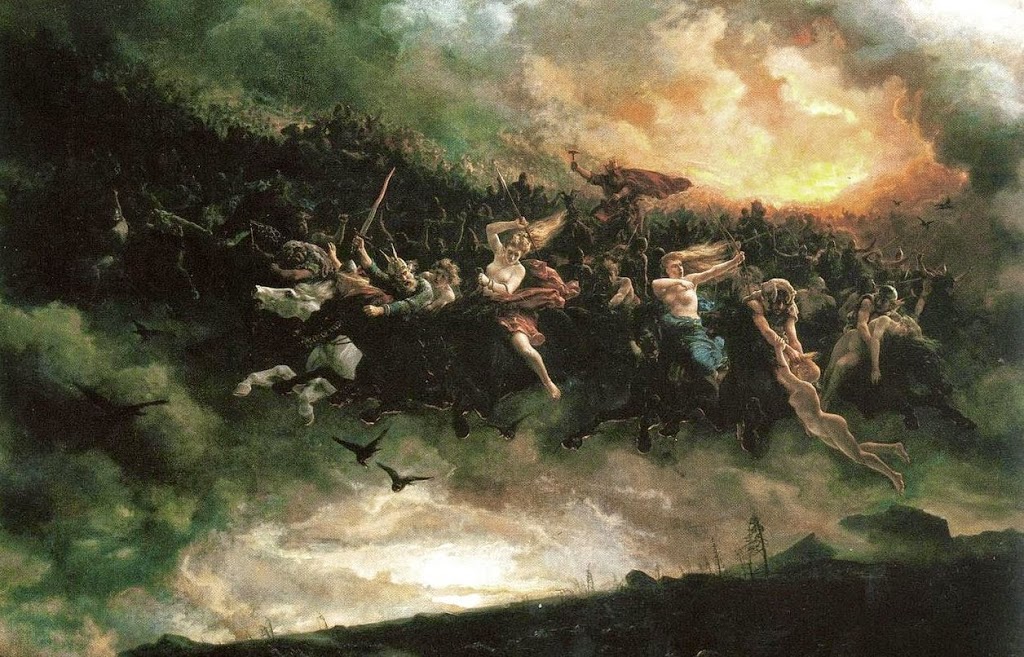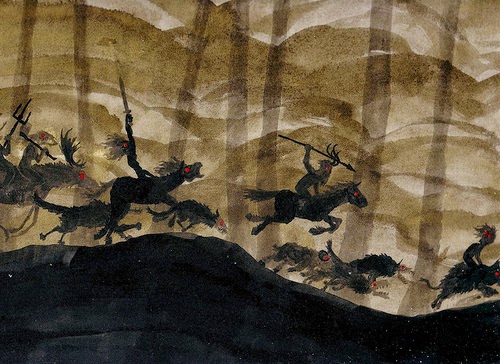
Thy rest was deep at the slumberer’s hour
If thou didst not hear the blast
Of the savage horn, from the mountain-tower,
As the Wild Night-Huntsman pass’d,
And the roar of the stormy chase went by,
Through the dark unquiet sky!
The convent’s chanted rite was stay’d,
And the hermit dropp’d his beads,
And a trembling ran through the forest-shade,
At the neigh of the phantom steeds,
And the church-bells peal’d to the rocking blast
As the Wild Night-Huntsman pass’s.
Felicia Dorothea Hemans (1793 – 1835)
From “The Wild Huntsman”
“The Forest Sanctuary and Other Poems”
If thou didst not hear the blast
Of the savage horn, from the mountain-tower,
As the Wild Night-Huntsman pass’d,
And the roar of the stormy chase went by,
Through the dark unquiet sky!
The convent’s chanted rite was stay’d,
And the hermit dropp’d his beads,
And a trembling ran through the forest-shade,
At the neigh of the phantom steeds,
And the church-bells peal’d to the rocking blast
As the Wild Night-Huntsman pass’s.
Felicia Dorothea Hemans (1793 – 1835)
From “The Wild Huntsman”
“The Forest Sanctuary and Other Poems”
When the sounds of howling dogs and screaming hags fill the air with hunters following behind, the wise traveler will immediately cover his eyes and throw his body face down into the middle of the road. If he is lucky, no harm will come other than the cold feet of the Black Dogs running over him and a lingering sniffle from lying in the muddy road….
Åsgårdsreia is a pack of shifting forest-demons and animal-gods, thousands strong, which sweeps through the countryside killing everything in its path. A flood of horrific beasts, tentacled toads, insects of armor and spine, gelatinous serpents, vaporous beings with the face of gods, all poured forth from the great hollow tree, blind with fury.
In Scandinavia, Åsgårdsreia (Odin’s hunt) was heard but rarely seen. When Odin’s hunt was heard, it meant changing weather in many regions, but it could also mean war and unrest. According to some reports, the forest turned silent and only a whining sound and dog barks could be heard. According to lore, Odin does not ride, but travels in a wheeled vehicle, specifically a one-wheeled cart.
The Norse god Odin in his many forms, astride his eight-legged steed Sleipnir, came to be associated with the Wild Hunt in Scandinavia because of his aspect of berserking. Odin acquired the aspect of the Wild Huntsman, along with Frigg. The passage of this hunt was also referred to as Odin’s Hunt. People who saw the passing hunt and mocked it were cursed and would mysteriously vanish along with the host; those that joined in sincerity were rewarded with gold.
Åsgårdsreia is an ancient folk myth prevalent across Northern, Western and Central Europe. The fundamental premise in all instances is the same: a phantasmal, spectral group of huntsmen with the accoutrements of hunting, with horses and hounds in mad pursuit across the skies or along the ground, or just above it.
Perhaps not surprisingly since the majority of written accounts come from Christianized times recorded by monks that former powerful pagan gods and goddesses loom large as the leaders of the demonic hosts. One of the most famous and enduring Wild Hunt mythology strands comes from Germanic folklore from Germany, Norway, Sweden and Denmark, recounting how at Yuletide, Woden or Wotan in the Anglo Saxon tradition or Odin in Scandinavian lands led the Wild Hunt through the heavens. In pre Christian oral traditions it would seem, however, Odin chased wood elves or, sometimes, beautiful maidens at the Midwinter Solstice around December 21, one of the main times the Hunt was seen. Some accounts say he dropped gifts at the foot of his sacred pine for the faithful, possibly one of the origins of Christmas presents. Odin’s eight-legged horse Sleipnir was the source for the legend of the eight reindeer of Santa Claus. Santa himself was the old Holly King/Odin and Saint Nicholas rolled into one.
When Odin was demonized (he can still be seen in his devilish persona as Black Peter or Black Rupert in St Nicholas Day processions in Europe) Odin’s huntsmen and women became the ungodly dead, who unable to gain admission to heaven, were released from hell to hunt for souls.
The Hunt myth continued through Europe as a very useful deterrent by the clergy into Victorian times to prevent superstitious people frolicking illicitly after dark on pagan pursuits.
Seeing the demonic Host became in Christian times an omen of death within the year, an effective way of ensuring good folk were tucked up in their beds on the old pagan festivals. For the first appearance of Odin’s hunt was traditionally recorded as occurring on the Scandinavian pagan festival of Winternights in mid October, a little earlier than Halloween when the fairies were traditionally out riding to their winter quarters and would also capture unsuspecting mortals.






